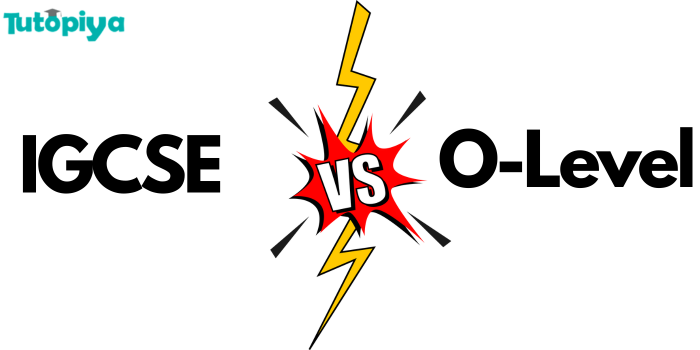Cambridge IGCSE vs O-Level: Importance, Curriculum Structure, and Key differences
Hi there! Do you wish to gain as much knowledge as possible regarding O-levels and IGCSEs? You’ve arrived at the right place! We’ll examine these notable qualifications and their significance in this blog post.
First off, students between the ages of 14 and 16 can earn the internationally recognized IGCSE, or International General Certificate of Secondary Education. It’s all about preparing you for the next phase of your educational journey.What about the O-levels, though?
Yes, they are comparable. IGCSE’s hip relatives are O-levels or ordinary-level exams. They span a wide variety of topic areas and are offered by students between the ages of 14 and 16.
These credentials are quite useful since they open doors to opportunities for additional education and eventually work. They assess your knowledge and skills in a range of academic areas to give you a well-rounded education.The best part?
Both O-level and IGCSE candidates can choose from a variety of flexible curriculum and assessment options. This suggests that you can concentrate on your interests and strong points.
Must Read: IGCSE vs GCSE: 5 differences you should know
Importance of choosing the right educational path for a child

A child’s future can be greatly impacted by selecting the appropriate educational route, thus it is important to do it properly. Each child is distinct, possessing distinct abilities, passions, and methods of learning.
We provide them with an environment that fosters their development and growth by choosing the right educational path. It enables children to flourish socially, emotionally, and academically.
In addition to helping them develop their potential and passion, the appropriate educational path positions them for achievement in their chosen industry. When considering such a choice, it’s critical to take into account each person’s unique needs and goals to provide them with the best opportunity to realize their potential and lead satisfying lives.
IGCSE Unlimited Learning Program
IGCSE vs O-levels: Which one to Choose?

When deciding between IGCSE and O-levels, it’s vital to assess your child’s specific needs and ambitions. IGCSE students are well-prepared for future employment opportunities and higher education by acquiring a globally recognized degree.
It enables flexibility in topic selection and evaluation, appealing to a wide range of passions and strengths. O-levels, on another note, are recognized all around the globe and contain an extensive list of disciplines. Several testing organizations distribute them.
You must recognize your child’s goals and interests, as well as speak with teachers, to make an informed decision. Given that both certificates can help the child flourish, make an informed decision based on their specific needs.
Must Read: IGCSE vs GCE O Levels: The Difference Between Cambridge
Curriculum Structure IGCSE vs O-levels
Let’s look at the IGCSE and O-level curriculum structures. Both certifications provide a diverse selection of disciplines from which students can select according to their hobbies and strengths. There are, nevertheless, some significant variances.
The IGCSE programme is a two-year programme with assessments at the conclusion. It usually consists of a combination of basic disciplines such as English, mathematics, and science, as well as electives.
Must Read: Master the IGCSE: Your Complete Guide to Success
O-levels, on the other hand, are typically a one-year programme with final examinations. They cover the same subjects but are given by separate examination boards.
Overall, both credentials offer an extensive course of study that educates students for further education and possible job paths.
Start Today: O Level Tuition Online: Improve your Singapore GCE O Level Grades
Key differences between IGCSE and O- Levels
| Key points | IGCSE | O-levels |
| Structure | Two-year program with assessments at the end | Usually one-year program with examinations at the end |
| Subject Choices | Provides a diverse selection of studies, often ranging from 70 to 80 courses across many fields, allowing students to select classes based on their preferences. Provides a broader international range of topics. | More than 40 subjects are available in any combination.
The O Level curriculum stresses comprehensive and balanced study in a variety of disciplines. |
| Grading System | Uses an A* to G scale for grading | Uses a numerical grading system from 1 to 9 |
| Global Recognition | Recognized globally, offers international qualification | Recognized globally, although some variations in recognition based on country or institution |
| Flexibility | Allows flexibility in subject choices and assessments | Provides flexibility in subject choices and assessments |
| Implications | Prepares students for higher education and future career opportunities | Prepares students for higher education and future career opportunities |
| Administration | Administered by Cambridge Assessment International Education | Managed by various examination boards in different countries |
Start Today: IGCSE Tuition SG | Tutor For English, Maths, Science Revision
Regional Variations of IGCSE & O-levels

Certainly! The demand of IGCSE and O-levels varies by location, and local tastes or patterns can influence qualification selection.
Overall, IGCSE is generally popular and internationally recognized. International schools frequently provide it, particularly in locations in which English is not the main language. It is also common in countries that use the British school system or have significant ties to the United Kingdom.
O-levels, on the other hand, have a connection with British education and have traditionally been popular in former British colonies such as Singapore, Malaysia, and India. However, O-levels have changed in recent years, with several nations shifting to the IGCSE or other local credentials that correspond with their national education systems.
Must Read: Best Online IGCSE Tuition in Singapore for 2024 Success
Costs and Accessibility of IGCSE & O-Levels
Choosing between IGCSE and O-levels involves considering financial factors and accessibility of study materials. The cost of each varies, with IGCSE often being perceived as slightly more expensive due to its international nature. However, O-levels can also incur costs for exam fees and study resources.
Accessibility of study materials depends on your location and educational institution. IGCSE materials may be more widely available globally, but O-level resources can be found locally. Consider your budget and the ease of obtaining study materials when deciding between the two, ensuring a balance between affordability and accessibility for a successful academic journey.
Start Learning – Free IGCSE Resources for Students
Why is Tutopiya the best option for IGCSE and O- Level Tuition?
Tutopiya’s personalized approach and experienced tutors make it the best option for IGCSE and O-level tuition. Tutopiya prioritizes individualized learning by customizing its lessons to meet the specific needs of each student and guarantee a thorough comprehension of the curriculum.
The platform features seasoned instructors who are skilled at simplifying difficult ideas and creating a nurturing learning atmosphere. Tutopiya’s interactive online platform and flexible scheduling further improve accessibility, enabling learners to learn at their speed.
Tutopiya offers excellent IGCSE and O-level education by combining knowledge, flexibility, and dedication to student achievement.
Conclusion
Choosing between IGCSE and O-levels for your child involves weighing factors like curriculum preference and academic goals. IGCSE offers a more internationally recognized curriculum, fostering a global perspective.
O-levels, on the other hand, provide a locally focused syllabus that may align better with specific educational systems. Consider your child’s future academic path and aspirations when deciding.
IGCSE opens doors to diverse international opportunities, while O-levels cater to a more regional context. Ultimately, both certifications are reputable, so choosing the right fit depends on your child’s strengths, preferences, and future ambitions.
